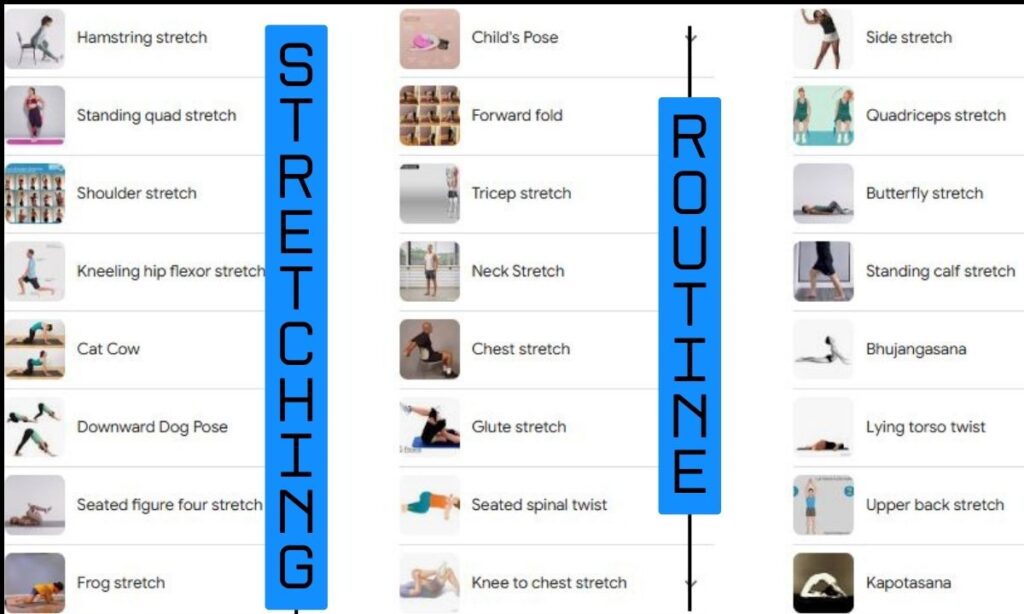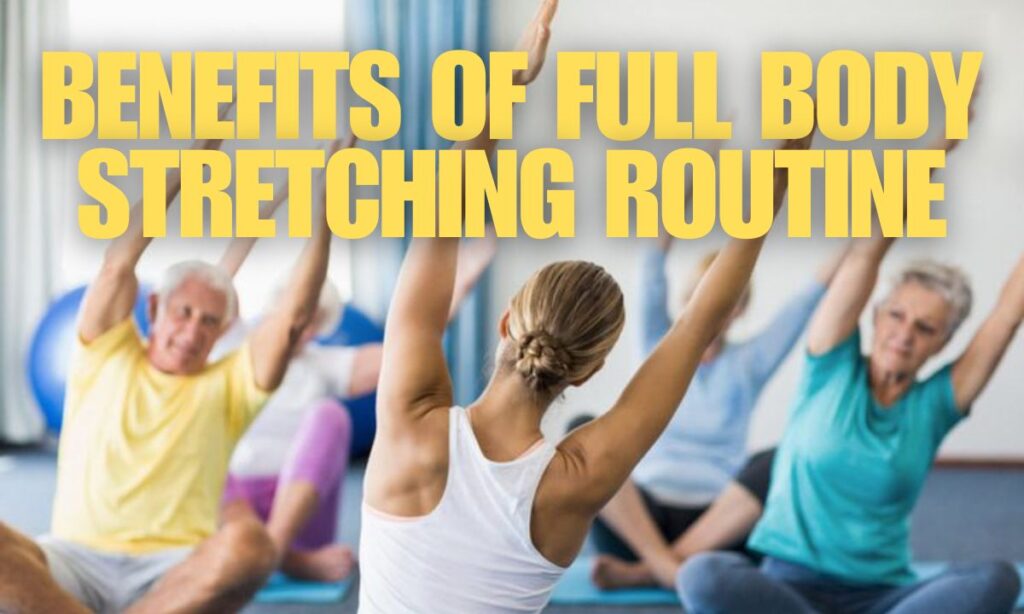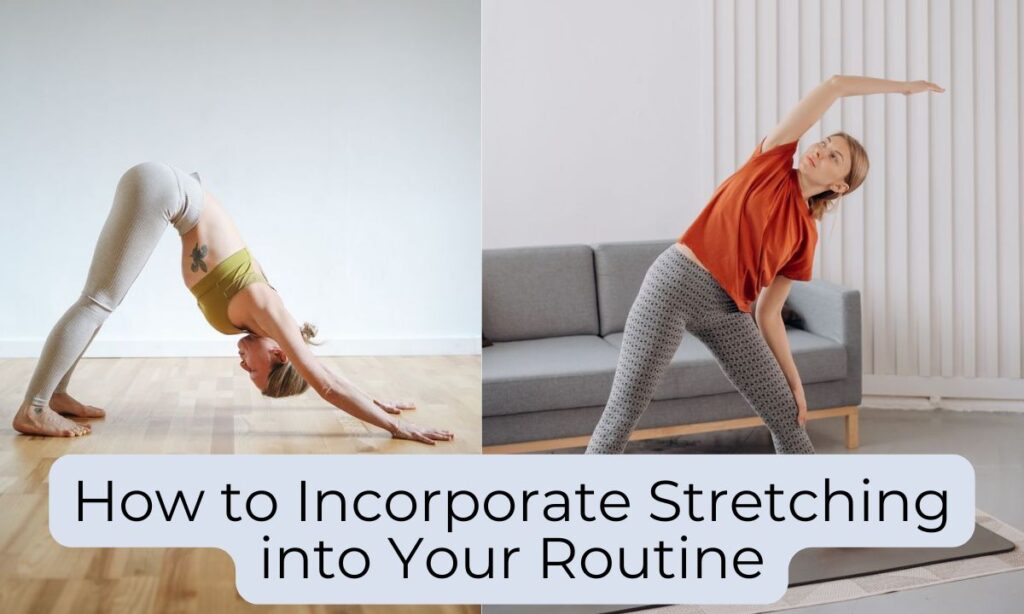The 5 Ultimate Full Body Stretching Routine: Enhance Flexibility, Reduce Stress, and Boost Your Health

Full Body Stretching Routine isn’t just for athletes; it’s an essential practice for anyone looking to improve their flexibility, prevent injuries, and relieve tension. A consistent full body stretching routine can do wonders for your body and mind. Whether you’re an office worker spending long hours at a desk or an active individual looking to increase performance, adding stretches to your daily regimen offers numerous benefits.
In this guide, we’ll walk you through the best stretching exercises to target each major muscle group, offer tips for getting the most out of each movement, and explain why stretching is a cornerstone of overall wellness.
Benefits of Full Body Stretching Routine

Before diving into the routine, let’s talk about why stretching is so important. Here are some key benefits:
- Improved Flexibility: Regular stretching helps lengthen your muscles, allowing for a greater range of motion.
- Better Posture: Stretching can improve your posture by loosening tight muscles, especially those in the neck, shoulders, and upper back.
- Reduced Stress: Stretching relaxes the muscles and calms the mind, making it a great way to reduce physical and mental tension.
- Improved Circulation: Stretching helps your muscles receive more blood, which speeds up healing and lessens discomfort.
- Reduced Risk of Injury: Flexible muscles are less prone to injury, making stretching a great addition to any fitness routine.
Warm-Up: The Foundation of a Good Stretching Routine
Warming up before beginning any stretching routine is essential. A proper warm-up raises your heart rate, increases blood flow to the muscles, and prepares them for the stretches ahead. You can do a quick 5–10 minute warm-up, such as jogging in place, jumping jacks, or dynamic movements like leg swings. This will help you get the most benefit from your stretching session and reduce the risk of muscle strain.
1. Neck and Shoulder Stretch
If you spend long hours at a desk, your neck and shoulders are likely tense. This stretch helps release tension and improve flexibility in these areas.
- Sit or stand with a straight spine.
- Tilt your head gently to the right, bringing your ear toward your shoulder. Hold for 15–20 seconds.
- Switch to the other side.
- To deepen the stretch, place your hand on top of your head and gently pull.
- Repeat for 2–3 rounds on each side.
Tip: Avoid hunching your shoulders during this stretch.
2. Chest Opener
This stretch counteracts the tightness from sitting and can improve your posture.
- Clasp your hands behind your back and stand up.
- Straighten your arms and slowly lift them, feeling the stretch in your chest.
- Hold for 20–30 seconds, focusing on breathing deeply.
- Release and repeat 2–3 times.
Tip: Keep your shoulders relaxed and don’t overextend your arms.
3. Standing Side Stretch
The standing side stretch targets the obliques, helping to improve flexibility in your torso.
- Stand with your feet hip-width apart.
- Raise your right arm overhead, keeping your shoulder relaxed.
- Gently lean to the left, feeling the stretch along the right side of your body.
- After 20 to 30 seconds of holding, move on to the opposite side.
- Repeat 2–3 times on each side.
Advice: Don’t arch your lower back and maintain an active core.
4. Cat-Cow Stretch
This popular yoga pose is perfect for increasing flexibility in the spine and relieving lower back tension.
- Start on all fours, with your wrists aligned under your shoulders and your knees under your hips.
- Take a breath and raise your head and tailbone in Cow Pose by arching your back.
- As you round your back and tuck your chin and tailbone into Cat Pose, release your breath.
- For one to two minutes, alternate between these stances gently.
Tip: Focus on your breathing and move at a comfortable pace.
5. Forward Fold (Hamstring Stretch)
A forward fold stretch targets the hamstrings and can help reduce lower back tension.
- Maintain a hip-width distance between your feet and progressively lean forward, reaching for your toes.
- Let your head and arms hang, feeling the stretch in the back of your legs.
- Hold for 20–30 seconds, then slowly roll up to standing.
- Repeat 2–3 times.
Tip: Bend your knees slightly if you feel too much tension in your lower back.
6. Hip Flexor Stretch
Hip flexor tightness can result from prolonged sitting.This stretch can help improve mobility in your hips.
- Kneel on your right knee, with your left foot forward and knee at a 90-degree angle.
- Gently push your hips forward, feeling the stretch in your right hip.
- Hold for 20–30 seconds, then switch sides.
- Repeat 2–3 times per side.
Tip: Keep your back straight and avoid leaning too far forward.
7. Quad Stretch
A big muscular group at the front of your thighs is called the quadriceps. This stretch can help with knee and hip flexibility.
- Grab your right ankle while standing on your left leg, pulling your heel up to your glutes.
- Hold the stretch for 20 to 30 seconds while keeping your knees close together.
- Switch sides and repeat 2–3 times.
Tip: Focus on keeping your balance by holding onto a wall or chair if needed.
8. Calf Stretch
Ankle and foot pain might be exacerbated by tight calves. This stretch helps improve flexibility in the lower leg.
- Stand facing a wall with your hands on it for support.
- Step back with your right leg, keeping it straight and pressing your heel into the ground.
- Bend your left knee slightly and lean forward until you feel a stretch in your right calf.
- Hold for 20–30 seconds, then switch sides.
Tip: Keep your back leg straight and your heel on the ground.
9. Seated Spinal Twist
This stretch relieves lower back strain and improves spine flexibility.
- Place your legs out in front of you while sitting on the floor.
- Position your right foot on the outside of your left knee while bending your right knee.
- Looking over your shoulder, rotate to the right while placing your left elbow on the outside of your right knee.
- Hold for 20–30 seconds, then switch sides.
Tip: Breathe deeply and try to relax your shoulders.
10. Child’s Pose
Child’s pose is a mild stretch that lengthens the spine and promotes bodily relaxation.
- Start on all fours and slowly sit back onto your heels, reaching your arms forward.
- Hold for one to two minutes after lowering your forehead to the floor.
- Breathe deeply, allowing your body to relax.
Tip: If you feel any discomfort, place a cushion under your hips or forehead.
How to Incorporate Stretching into Your Routine

Consistency is essential if you want to reap the full advantages of stretching. Aim to stretch at least 3–4 times per week, or ideally every day. You can do this routine in the morning to energize yourself, as part of a cool-down after a workout, or in the evening to relax before bed.
Conclusion
A regular full body stretching routine is one of the best gifts you can give to your body. It doesn’t require much time or equipment—just commitment and patience. By incorporating these stretches into your routine, you’ll feel more flexible, less tense, and more aligned. So take a few minutes out of your day, roll out a mat, and show your body some love. Start stretching and experience the positive effects on your physical and mental health!
FAQ :
- How long to recover after complete body stretching regimen ?
It typically takes 24 to 48 hours for your body to heal from tiny injuries in your muscles after a full body stretching session. Rest days enable your body and mind to recuperate and rejuvenate, enabling you to put in the necessary effort during your subsequent workout. - How to do full body stretching routine
- What is a suitable stretching regimen for the entire body?
Hamstring stretch
Quadriceps stretch
Hip flexor stretch
Calf stretch
Kneeling hip flexor stretch
Triceps stretch
Standing quad stretch
Chest stretch - Full Body stretching routine pdf ? Click Here Download
- How to make a stretching routine?
Ideally, you should incorporate at least one stretch for each of the main muscle groups in your body into your regular stretching regimen.. For one to four repetitions, Gondek often suggests holding individual stretches for 15 to 30 seconds. She goes on to say that “older adults need more than 30 second hold times, up to 45 seconds.” - What is the best Full Body stretching routine ?
Hamstring stretch while lying down. With one leg straight up over the hip joint and the other leg stretched on the floor, with the toes drawn toward the chin, lie on your back.
From ankle to knee (Figure 4)…
twisting the torso when lying.
Plank, cobra, runner’s lunge, pigeon, and shoulder stretch are some exercises. - Full body stretching routine for beginners ? Read more
- Full body stretching routine at home ? Read More
